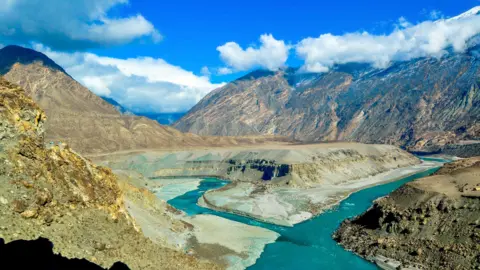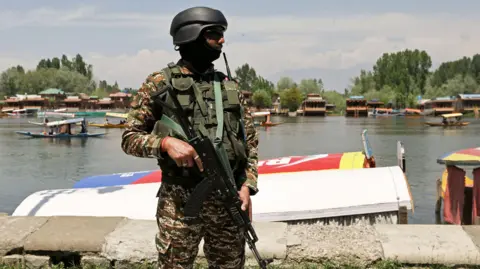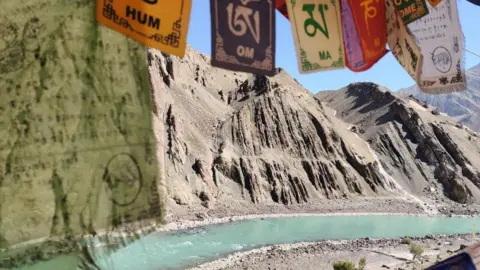Environmental correspondent, BBC World Service
 Getty images
Getty imagesWill India be able to prevent the Industry River and two of its tributaries from flowing in Pakistan?
This is the question in many spirits, after India has suspended a major treaty governing the sharing of water of six rivers in the Indus basin between the two countries, after the horrible attack on Tuesday to the cashmere administered by the Indians.
The 1960s (IWT) water Treaty survived two wars between nuclear rivals and was considered an example of transfusionary water management.
The suspension is one of several stages that India has taken against Pakistan, accusing him of supporting cross -border terrorism – an accusation of Islamabad categorically denies. He also retaliated with reciprocal measures against Delhi, and said that the stopping of water flow “will be considered an act of war”.
The Treaty awarded the three Eastern rivers – the Ravi, Beas and Sutlej – from the Industry basin to India, while 80% of the three Westerners – Indus, Jhelum and Chenab – in Pakistan.
Disputes have evolved in the past, Pakistan opposing some of the hydroelectric and water infrastructure projects, arguing that they would reduce rivers flows and violate the treaty. (More than 80% of Pakistan agriculture and around a third of its hydroelectricity depend on water from the Indus basin.)
 EPA
EPAIndia, on the other hand, pushed to examine and modify the treaty, citing changing needs – from irrigation and drinking water to hydroelectricity – in the light of factors such as climate change.
Over the years, Pakistan and India have continued competing legal avenues under the Treaty negotiated by the World Bank.
But it is the first time that each side has announced a suspension – and in particular, it is the country upstream, India, giving it a geographical advantage.
But what does the suspension really mean? Could India hold back or divert the waters from the Indus basin, depriving Pakistan from its life buoy? And is it even able to do it?
Experts say that it is almost impossible for India to retain tens of billions of cubic meters of Western rivers during high speed periods. It is missing both the massive storage infrastructure and the vast canals necessary to divert such volumes.
“India’s infrastructure is mainly hydroelectric power plants at the river that do not need massive storage,” said Himanshu Thakkar, a regional expert in water resources in the southern Asia on dams, rivers and people.
These hydroelectric power plants use running water strength to run turbines and produce electricity, without retaining large volumes of water.
Indian experts claim that inadequate infrastructure has prevented India from fully using its share of 20% of the waters of Jhelum, Chenab and the Indus under the treaty – a key reason that they argue for the construction of storage structures, that Pakistan is opposed to citing the provisions of the Treaty.
Experts say that India can now change the existing infrastructure or build new ones to retain or divert more water without informing Pakistan.
“Unlike the past, India will not now be required to share its project documents with Pakistan,” said Thakkar.
 Getty images
Getty imagesBut challenges like difficult terrains and protests within India itself on some of its projects have meant that the construction of aquatic infrastructure in the Indus basin has not moved quickly enough.
After a militant attack on the cashmere administered by the Indians in 2016, officials of the Indian Ministry of Water Resources had declared to the BBC that they would accelerate the construction of several dams and water storage projects in the Indus basin.
Although there is no official information on the state of these projects, sources say that progress has been limited.
Some experts say that if India is starting to control the flow with its existing and potential infrastructure, Pakistan could feel the impact during the dry season, when the availability of water is already the lowest.
“A more urgent concern is what is happening during the dry season – when the flows through the basin are lower, storage is more important and the timing becomes more critical,” wrote Hassan F Khan, assistant professor of urban environmental policy and environmental studies at Tufts University, in the Dawn newspaper.
“This is where the absence of treaty constraints could start to feel more acute.”
 Getty images
Getty imagesThe Treaty requires that India Sharing Hydrological Data with Pakistan – crucial for the forecast of floods and the planning of irrigation, hydroelectricity and drinking water.
Pradeep Kumar Saxena, the former IWT commissioner in India for more than six years, told the press agency Press Trust of India that the country can now stop sharing data on floods with Pakistan.
The region sees harmful floods during the monsoon season, which begins in June and lasts until September. But the Pakistani authorities said that India already shared very limited hydrological data.
“India only shared 40% of the data before it even made the last announcement,” the former Pakistan’s additional commissioner told BBC Urdu, Pakistan’s additional commissioner.
Another problem that arises whenever there are water -related tensions in the region is that the country upstream can “arm” water against the downstream country.
It is often called a “water bomb”, where the country upstream can temporarily retain water and suddenly release it, without warning, causing massive damage downstream.
Could India do this?
Experts say that India is at first risking flooding its own territory because its dams are far from the Pakistani border. However, he could now rinse the silt of his tanks without prior warning – potentially causing downstream damage to Pakistan.
The Himalayan rivers as the Industry bear high silt levels, which accumulate quickly in dams and dams. The sudden rinsing of this silt can cause significant downstream damage.
There is a larger image: India is downstream from China in the Brahmapoutre basin, and the Indus is from Tibet.
In 2016, after India warned that “blood and water cannot flow together” following a militant attack on cashmere administered by the Indians that Indians blamed in Pakistan, China blocked an tributary of the Yarlung Tsangpo – which becomes brahmapoutre in northeast India.
China, which has Pakistan as an ally, said they had done so because it was necessary for a hydroelectric project that they built near the border. But the time of the move was considered Beijing to help Islamabad.
After having built several hydroelectric power plants in Tibet, China has green-green in green which will be the largest barrage in the world on both parts of Yarlung Tsangpo.
Beijing claims a minimal environmental impact, but India fears that it will give China a significant control over the flow of the river.



